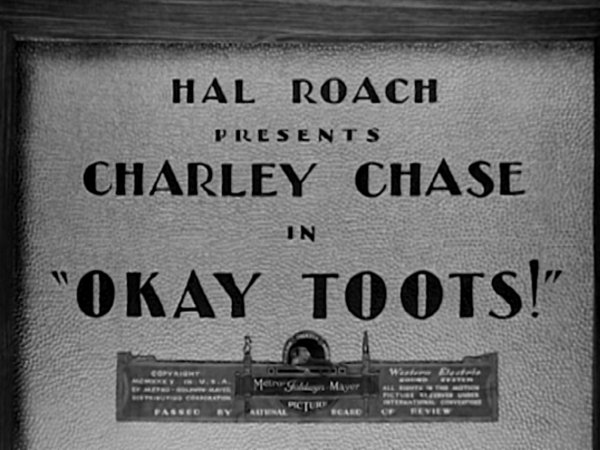
Okay Toots!
 |
Available on DVD:![Charley Chase At Hal Roach: The Talkies Volume Three 1934-1936 (The Sprocket Vault, 2021) [USA]](web_images/dvd-charley_chase_34-36.jpg)
|
|
Screenshots are from an inferior (non-DVD) print; plot summary written by Robert Winslow for this site: We open on the interior of an office. One of the office workers is telling his co-workers how lucky Charley Chase is – unable to pronounce the tongue-twisting name of a stock venture, he suggested General Motors, which went up ten points. We then see Charley exiting his boss’s office, as the boss (Ferdinand Munier) compliments Charley on his financial acumen. “You have the monetary mind of a Mellon!” he tells Charley, before asking his opinion on a railroad stock, the “Topanga and Tehachapi.” Flustered, Charley says he still prefers General Motors. The boss departs, and Charley’s co-workers ask “What was the name of that stock?” mentioned by the boss. Charley still can’t get his tongue around its name, so he replies, “Aw, Standard Oil!” After a musical interlude when Charley phones home to tell his wife the good news and sings “I’ve Found My Place in the Sun,” Charley leaves work and goes outside. He gets into an argument with a motorist who, as Charley backs his car from its parking space, occupies the space he’s just vacated. Deciding to move another car blocking his way, Charley is accused by that car’s owner of auto theft. Charley demands his rights, and a traffic cop lectures the car’s owner before the owner reveals himself to be Alfred Smith – police commissioner. The traffic cop is summarily fired, and the angry traffic cop shoves Charley against the commissioner’s car, putting a sizeable dent in its door and leaving the hapless commissioner yelling for the police. Charley arrives home. Madame Gaga, the clairvoyant, is entertaining Charley’s wife Toots and a number of her friends. Charley takes umbrage when he learns Toots has spent her afternoon pursuing such fakery and not preparing a meal. Toots explains they can go out for a “snack,” and Charley erupts. Taking Madame Gaga’s deck of cards, he states he wishes he had nothing to do all day but lie around “so that when my poor husband gets home, I can give him a snack!” Not to be outdone, Toots also cuts the cards, wishing she could have Charley’s life, in a “cool office surrounded by beautiful stenographers.” Charley goes upstairs for a nap in exasperation, complaining “I’m a slave!” |
|
Charley falls asleep, and begins dreaming. When he awakens, it seems to be morning, and he goes down to breakfast. When he speaks, it’s with Toots’ voice, and when Toots enters, she speaks with Charley’s voice. Toots prepares to leave for the office, stating Charley must not be feeling so well. She calls in Hattie, the maid (Hattie McDaniel). She then phones Dr. Kinsey to tell him Toots is acting “a little queer.” Hattie, meanwhile, wants to undress Charley and put him to bed. When Charley resists, she emphatically says, “Well, it wouldn’t be the first time!”
The boss is having a party at his penthouse apartment that evening. Charley and Toots arrive, with Toots cautioning Charley that many important businessmen will be there. As Toots mingles with the boss and a businessman, Charley is sent off to mingle with the other wives, who comment on the fedora Charley is wearing. “So chic!” one exclaims. “I usually wear a derby,” Charley informs them. The women adjust Charley’s hat becomingly. Charley gets away from them and goes onto the penthouse’s patio, accidentally stepping into its decorative fountain. He then begins to bawl at his ill luck. “What will I do? I can’t keep house. I can’t even do fancy work!” he says before breaking down in tears. The film returns to the bedroom, where Charley thrashes about on the bed in a bad dream. He awakens, and immediately goes to Toots, telling her they’ll go for a snack – “a hundred snacks!” He sings a reprise of “I’ve Found My Place In the Sun,” and the film fades out. |
| Trivia • Copyrighted May 2, 1935. • This was the first of four appearances in a Charley Chase short from Constance Bergen. • The song Charley sings to his wife down the telephone is "I've Found My Place In The Sun". • The glass panel door which Charley opens to leave the office has the words "Universal Importers Inc." etched on it (though it is seen backwards). • After Charley confronts the irate man and his obnoxious brother on the street he turns to walk back to his car. On the bottom-left of the screen you can see a man wearing a white hat, reflected in the car's side window and crouching down pushing the film camera along the street. See here. • The film’s title, “Okay, Toots,” derives from a song of the same title sung by Eddie Cantor in the film KID MILLIONS, released in November 1934. • At the party, the guests are singing “Honolulu Baby” by T. Marvin Hatley as Charley and Toots arrive. • This was Jeanie Roberts’ only film with Chase. Presumably, she was chosen over Chase’s usual leading ladies of the time (Betty Mack and/or Constance Bergen) because of her distinctive, high-pitched squeaky voice, in order to contrast its sound with Chase’s baritone in the scenes where they exchange identities. • At the boss’s party, Charley is shown to be wearing lipstick though he’s otherwise dressed in masculine fashion, and Toots is shown in an evening dress and cape. • The police commissioner in the film, Alfred J. Smith, shares his name with former New York governor and 1928 US Presidential candidate Alfred “Al” Smith. • During his confrontation with the traffic cop and the commissioner, Charley claims to be “one of the Jones boys.” This is a reference to a well-known singing quintet of the era. Chase, a musician himself, would’ve known their work. • Topanga, mentioned in the dialogue about possible investments, is a beach town near Los Angeles. Tehachapi is both a mountain pass and small town in the San Gabriel Mountains of California. Despite the dialogue, there was no railroad connecting the points. • Standard Oil, one of the firms mentioned in the dialogue, was founded in 1870. In 1911 it was broken up into separate companies, with Standard Oil of California becoming the company name for its Western holdings. This portion is now known as Chevron in the US. John D. Rockefeller, one of Standard Oil’s founders, remained one of the wealthiest men in the US in the 1930s. • General Motors was chaired by Alfred P. Sloan in 1934. Like Rockefeller, he was wealthy and a notable philanthropist. • “Mellon” refers to Andrew Mellon, who served as US Secretary of the Treasury under Presidents Harding, Coolidge, and Hoover (1921-1933). • •Total coincidence, but Dr. Kinsey in the film (Allan Cavan) shares his name with Dr. Alfred Kinsey, who compiled the “Kinsey Report On Sexual Behavior in the Human Male” and “Sexual Behavior in the Human Female” in the late 1940s. Given the film’s subject matter, this seems an odd case of life imitating comedy art. • At the beginning of the dream sequence, the “dream” Charley sits up in bed, then picks up the clock to look at the time. When he sets down the clock, it’s double exposed, indicating Chase didn’t replace the clock in the exact same position as in the initial exposure, so that 2 clocks are visible, one transparent as the “dream” Charley is. “Fancy work,” which Charley doesn’t know how to do, refers to embroidery (it’s also spelled “fanciwork”). Charley indicates here that a woman’s role in the 30s consisted mostly of cooking, clothing, housekeeping, and bearing children. Robert Winslow's opinions • OKAY TOOTS returns Chase to the kind of gender-bending comedy he engaged in in such films as 1932’s MR. BRIDE and 1930’s FAST WORK. Since TOOTS dates from 1934-35, its humor is tamer, given the Production Code forbade overt depictions of effeminacy and compelled Chase to tone down what he called his “nance” characterization (“nance” being a 1930s euphemism for effeminate male). In fact, it’s a little difficult to determine in the film’s context exactly what the participants in the dream sequence are seeing. Since both Charley and Toots remain dressed normally as per their actual genders, do others see them as dressed according to the roles they’ve assumed? Thorne Smith, whose novel TOPPER would be filmed by Hal Roach about two years later, also penned a novel called TURNABOUT, in which an arguing and temperamental couple switch identities and gender roles. Smith’s novel had been published in 1931, and Roach would acquire its rights in 1939 for its own film adaptation, but one wonders if in 1934 Roach, or some of his staff, already were familiar with the work, given its basic resemblance to the plot of this film. In both instances, mystical powers cause the switch between husband and wife – in the novel, an Egyptian idol, in OKAY, TOOTS a clairvoyant’s pack of cards. TURNABOUT and OKAY, TOOTS then explore gender roles by having each person cope with the new identities that have been forced upon them. The chief difference in OKAY, TOOTS is that the switch is shown to be a dream, and when “Toots” acquires Charley’s voice and role, she seems unaware any change has transpired, while Chase becomes acutely aware of the limitations of his new identity, and his unsuitability for fulfilling this role. The film might have benefited from exploring this theme further – though a two-reel comedy may not provide sufficient time for real development. As it is, it’s an interesting evaluation – albeit from a man’s perspective – of the kind of social roles women occupied in the middle class of the1930s. Charley is expected to be docile and obedient to the male forces in his world, such as his “husband” and a male doctor. Women were expected to fulfill maternal obligations - other women comment on how Charley will lose his figure once he’s had children. At the party, while “Toots” hobnobs and exchanges banter with the boss and another businessman – who likewise exclaim over how “Toots’” figure will acquire a pot belly in middle age - Charley is shuttled off to partake in small talk with other women; the implication is that women have no place in business discussions and that social mixing of the sexes is strictly limited to formalized activities such as dancing (we see several dancing couples at the party, though Charley and “Toots” don’t participate). Women occupied a household sphere, in a holdover from the Victorian era, in which maids became intimate confidantes. (I can’t help comparing Hattie McDaniel’s small role here with her best-known film portrayal in GONE WITH THE WIND; the two roles, with McDaniel embodying both maternal concern and pragmatic wisdom, offer a good view of how this actress could invest such roles with a full range of expression; her double-take after Charley declines her help here, muttering “Fiddlesticks!”, presages her work in GWTW). Social roles here are rigidly and inescapably defined by gender according to separate spheres of existence. The result is a “comedy of manners” rather than outright flouting of gender roles, with Charley gaining some insight into the limited role a woman plays in the social life of her husband in contemporary society. It’s an interesting examination that remains quite sympathetic to the woman’s role, although reaffirming the status quo at the end, which may annoy present-day viewers. The dream sequence pairs OKAY, TOOTS with the Our Gang MAMA’S LITTLE PIRATE, produced around the same time. (Research hasn’t yet shown which film was filmed first; both were produced in the fall of 1934). Like Spanky in MAMA’S LITTLE PIRATE, Chase falls asleep and liberates a “dream” persona, who then fulfills the storyline set into motion during the preceding non-dream action. Both dreams turn rapidly into nightmares – Spanky’s with his encounter with a giant guarding the treasure he and the rest of the Gang have found, and Charley with his growing awareness of his inability to meet the gender role he’s been impelled into taking. Though the dream sequence occupies the largest segment of the footage, and derives most of its humor from characterization, OKAY, TOOTS also contains some visual humor, notably in the scene where Charley contends with getting out of a parking space. This sequence seems to build on one written by W.C. Fields for the 1933 Mack Sennett short TOO MANY HIGHBALLS, and which Fields himself would reprise and elaborate later in 1935 in THE MAN ON THE FLYING TRAPEZE. (Perhaps he saw what Chase had done with this material, as Fields was at work on TRAPEZE around the time this film reached theaters). Here Chase plays a role quite distinct from that later in the film, the kind of middle-class, hapless individual he portrayed in many of his 1930s films. OKAY, TOOTS is one of the milder Chase films. It demands careful viewing, and some knowledge of contemporary manners, to appreciate its humor. As such, it’s a film that doesn’t reach the gender subversion of MR. BRIDE or other pre-Code Chase comedies that derived humor from switching or satirizing gender roles. Although most reference sources give a February 2, 1935 release date for the film, it’s quite possible OKAY, TOOTS didn’t see release until the spring. (The copyright date of May 2 would tend to support a later release). Hal Roach’s short subject schedule had been disrupted by delays on the Laurel and Hardy feature BABES IN TOYLAND during the fall of 1934, resulting in delayed productions among the other comedy units due to personnel assigned to BABES being unavailable, BABES, which should have wrapped some time in September, had an extended production hiatus between August 16 and September 24. The expected release schedule – which was established prior to the start of the 1934-35 season by Fred Quimby, who headed MGM’s short subject distribution – proved impossible to meet, especially by the Our Gang unit, since Gus Meins, its usual director, was at work on BABES. Chase was less affected by the delays, but Art Lloyd, cinematographer on OKAY, TOOTS!,, had to be shared between Roach’s other series. It’s likely Lloyd’s work on this film occurred between his assignments on L&H’s THE LIVE GHOST (early November) and TIT FOR TAT (December 10-20). |
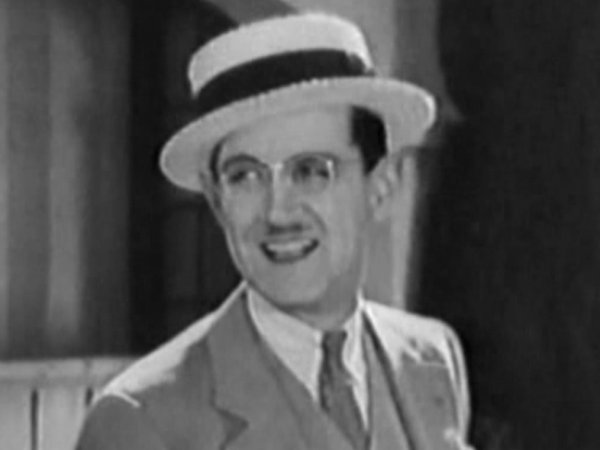 |
Charley Chase Charley Chase |
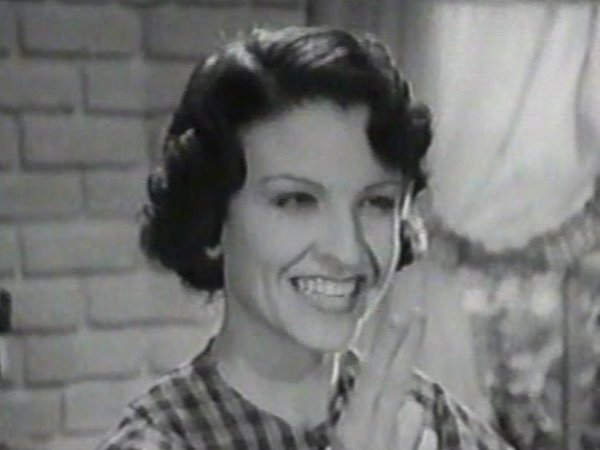 |
Jeanie Roberts Emily 'Toots' Chase |
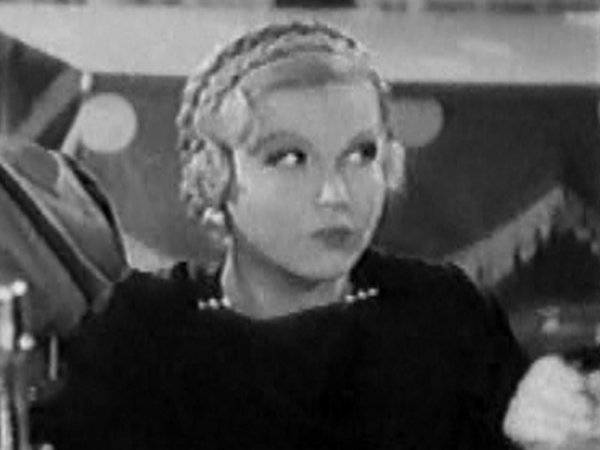 |
Constance Bergen Mrs. Brown |
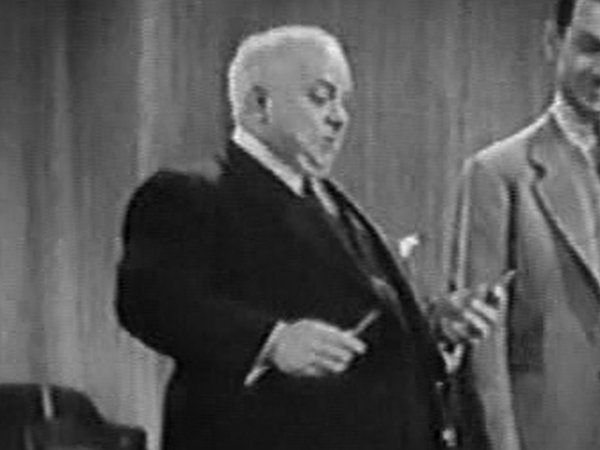 |
Ferdinand Munier Mr. Brown, the boss |
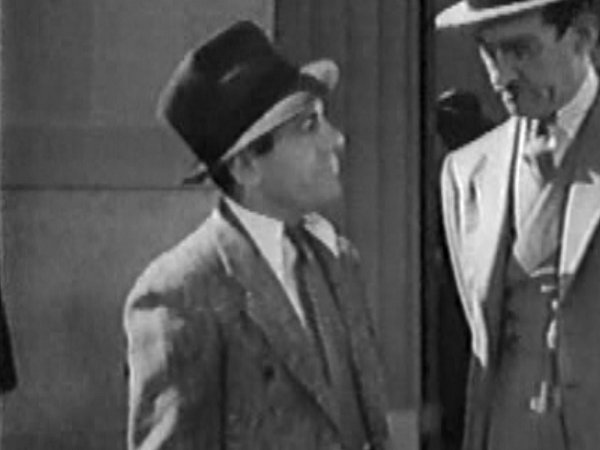 |
Charlie Hall Irate motorist |
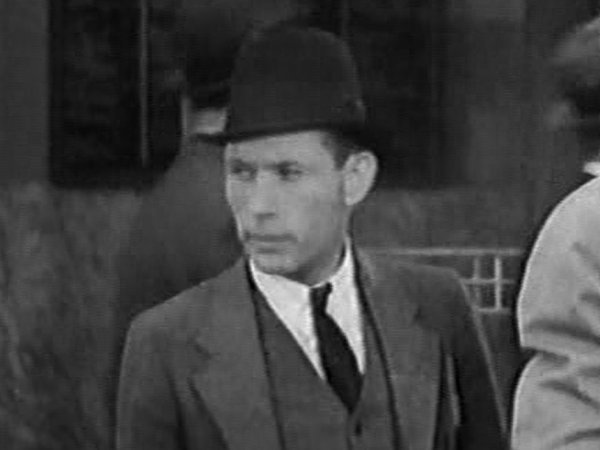 |
Ed Brandenburg Irate motorist's brother |
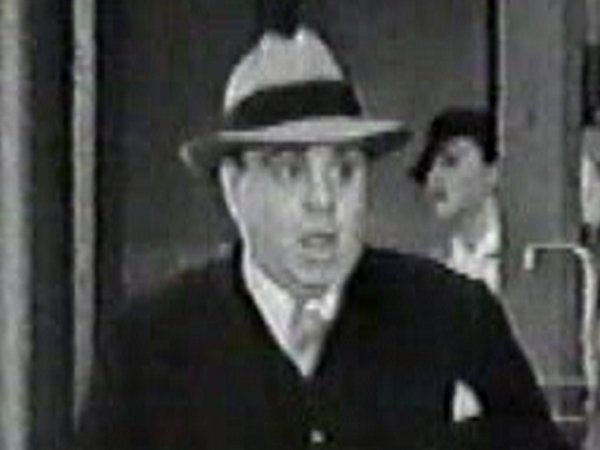 |
Ben Taggart Police commissioner Alfred J. Smith |
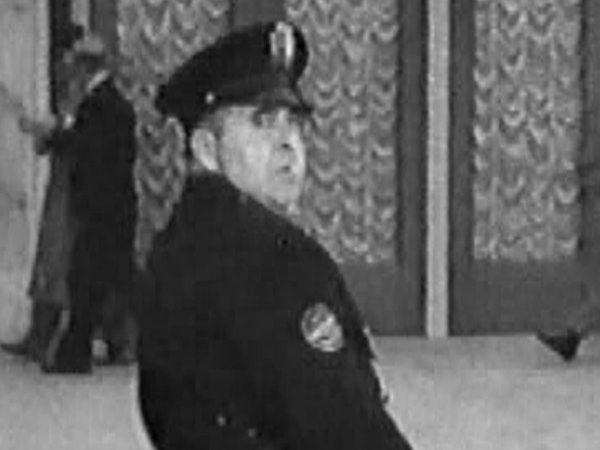 |
Jack Thomas Traffic cop |
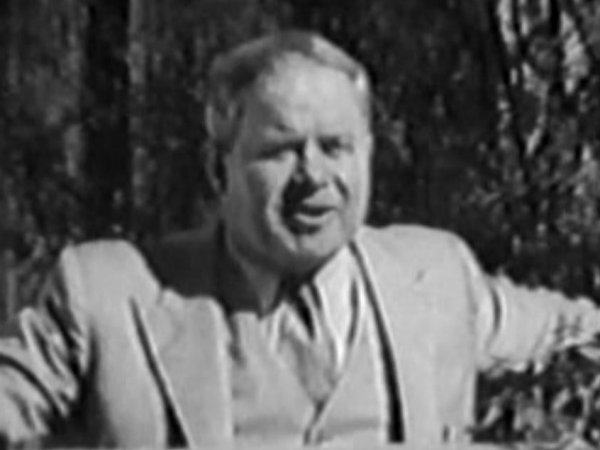 |
Harry Bernard Neighbor |
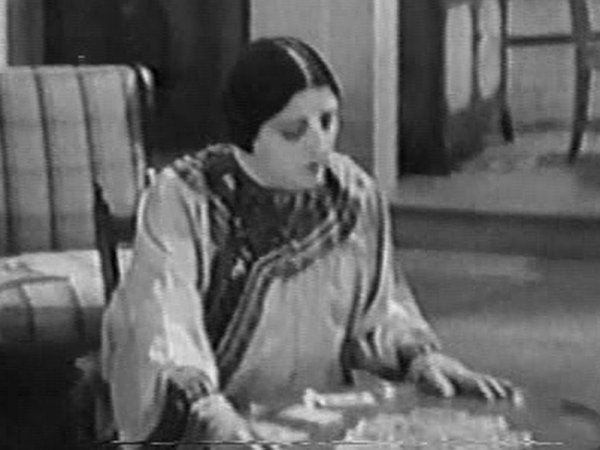 |
Ellinor Vanderveer Madame Gaga, fortune teller |
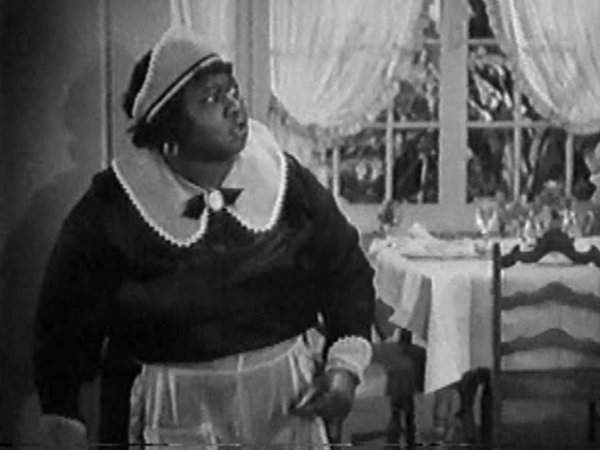 |
Hattie McDaniel Hattie, the maid |
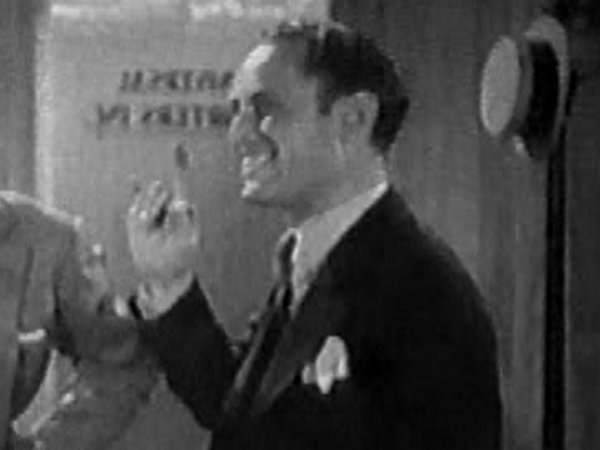 |
Stanley Price Party guest |
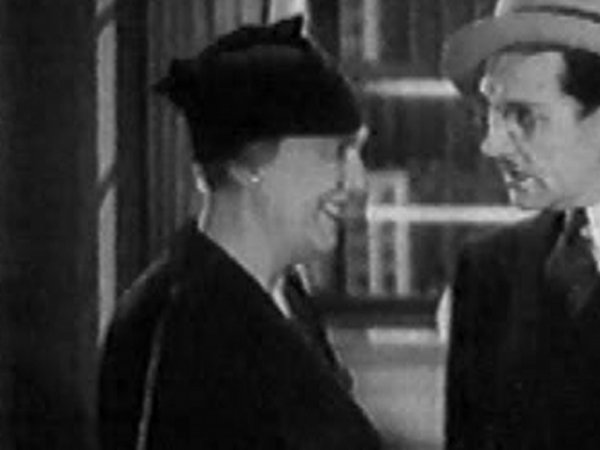 |
Grace Goodall Party guest |
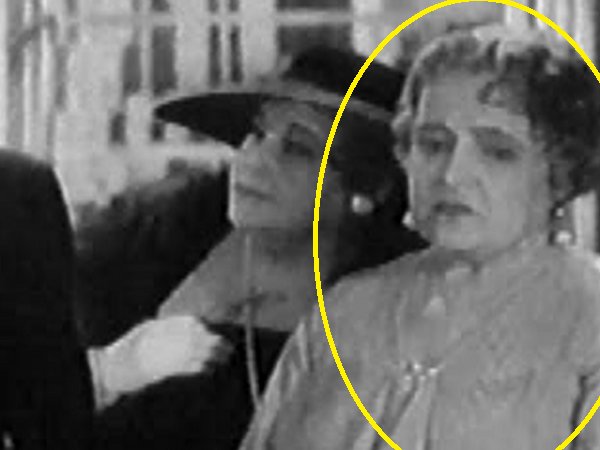 |
May Wallace Party guest |
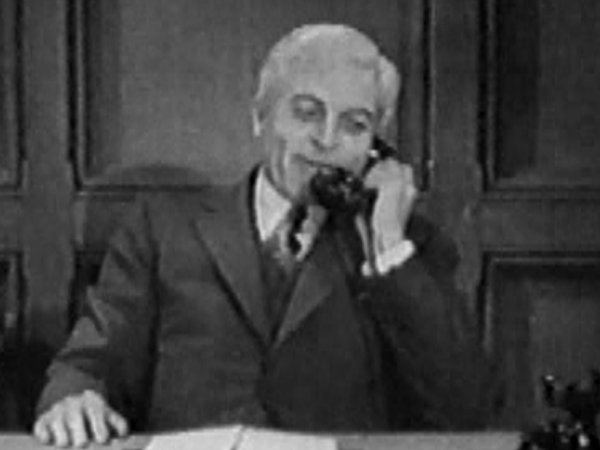 |
Allan Cavan Doctor Kinsey |
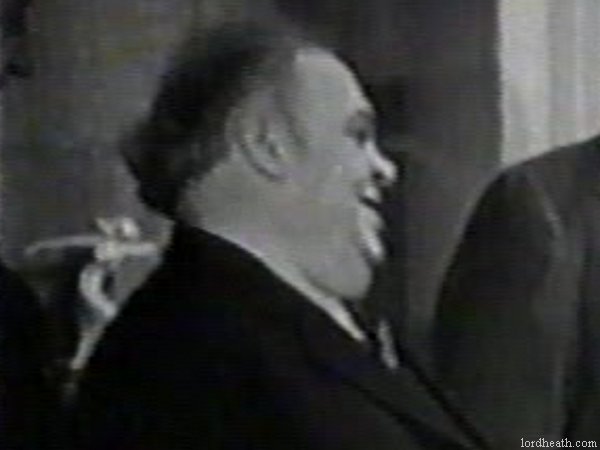 |
Scotty Mattraw Mr. Jones |
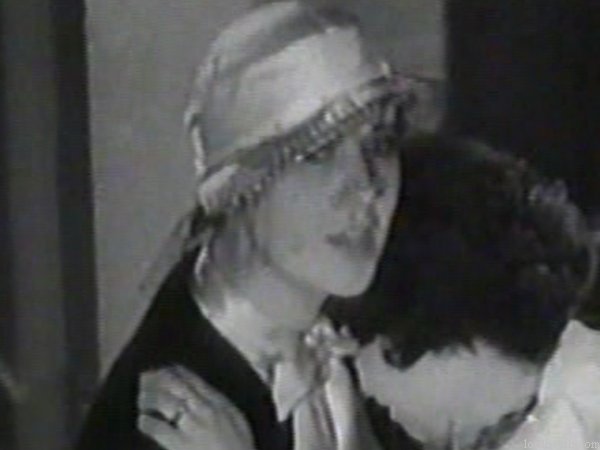 |
Bess Flowers Woman consoling Toots |
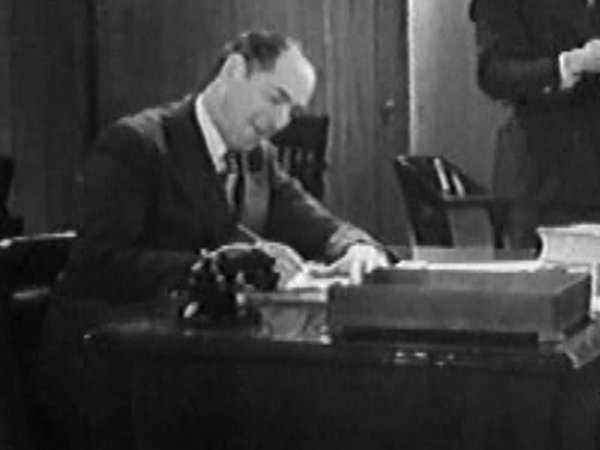 |
Baldwin Cooke Office worker |
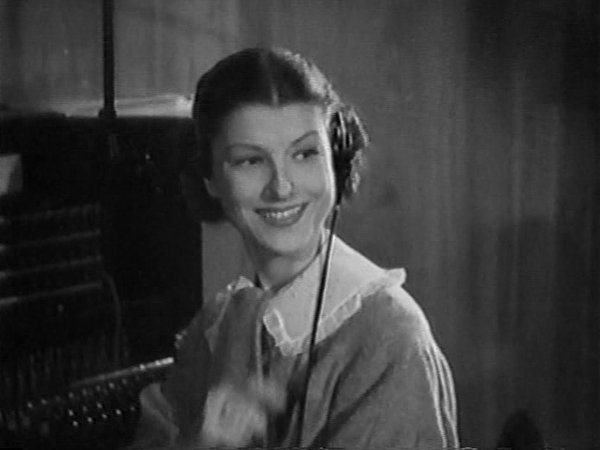 |
Polly Chase Office switchboard operator |
Frank Benson Butler |
Margaret Morgan Woman on street |
Bea Nigro Woman on street |
Pietro Sosso Butler |
Edward Thomas Butler |
| CREDITS (click image to enlarge) |
 |
| Acknowledgements: Smile When The Raindrops Fall by Brian Anthony & Andy Edmonds (book) Robert Winslow (review and trivia notes) This page was last updated on: 02 February2023 |